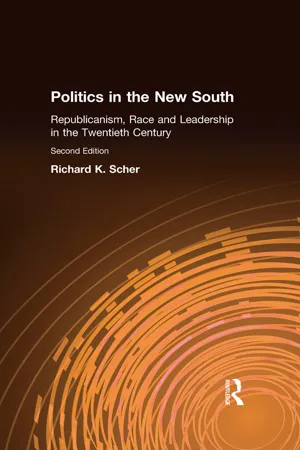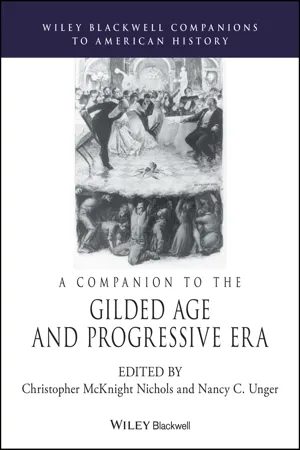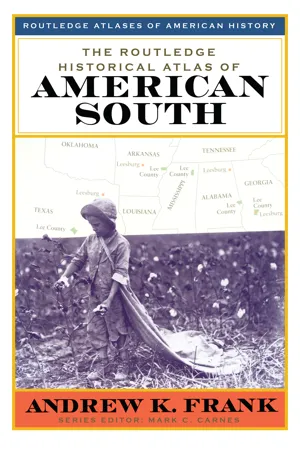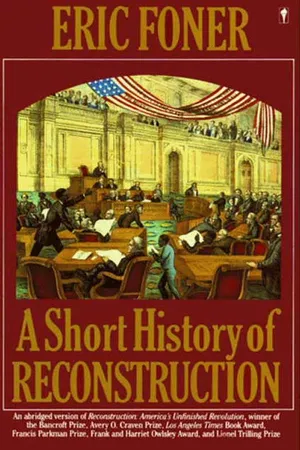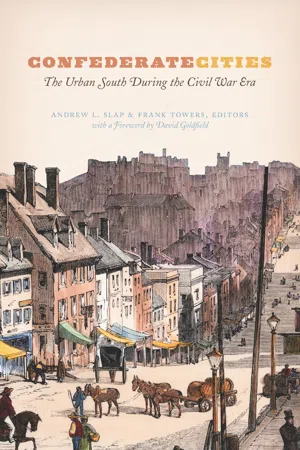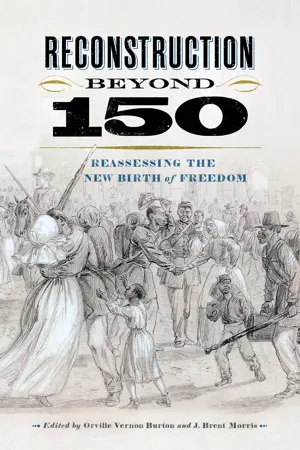History
The New South
The New South refers to the period of economic and social transformation in the southern United States following the Civil War. This era saw the rise of industrialization, urbanization, and the diversification of the region's economy. The New South also witnessed significant changes in race relations and the emergence of Jim Crow laws, which enforced racial segregation.
Written by Perlego with AI-assistance
Related key terms
8 Key excerpts on "The New South"
- eBook - ePub
- James S. Humphreys(Author)
- 2018(Publication Date)
- The Kent State University Press(Publisher)
Reconstruction, the Lost Cause, the industrialization of the South, southern agriculture, the politics of the South, and southern biography were all treated with a greater breadth and depth than ever before. With the notion of The New South a century old, studies synthesizing research on different eras of New South history became easier to write. In 1982, Daniel Joseph Singal shed light on the intellectual history of the South from the end of World War I to the completion of World War II. In 1988, Eric Foner argued that Reconstruction had not yet ended and that the main issues of the post–Civil War period continued to resonate in the late twentieth century. Reconstruction, he said, was “America’s unfinished revolution.” In the 1990s, John Egerton explored “the generation before the Civil Rights Movement in the South”; Numan Bartley illuminated The New South period from 1945 to 1980; and Edward L. Ayers provided a history of the entire New South era. By century’s end, writing about the region had experienced a revolution, one that deeply enriched the subject, but one that remained nevertheless “unfinished.” 53 R ECENT T RENDS The study of The New South has grown richer and more nuanced in recent decades because of the attention granted to new fields of inquiry: the role of women in The New South, the environmental history of the region, and the global influence of The New South. Gerda Lerner’s The Grimké Sisters: Rebels against Slavery (1967) stands out as a classic in women’s history. 54 Numerous presses rejected the book in the 1960s, telling Lerner that women’s history would not sell well. Officials of the Houghton Mifflin Company, however, accepted the manuscript and saw their gamble pay off. The book remains in print - eBook - ePub
Politics in the New South
Republicanism, Race and Leadership in the Twentieth Century
- Richard K. Scher(Author)
- 2016(Publication Date)
- Routledge(Publisher)
These are not trivial questions. At least since the end of the Civil War, if not earlier, journalists, scholars, politicians, visionaries, and other students of southern affairs have debated, sometimes acrimoniously, whether a new South could emerge. While there has never been agreement on the specific character of a new South, most suggested that it would be a region freed of the historical burden of slavery and defeat in the Civil War, humiliation during Reconstruction, and subsequent guilt about its peculiar position in American history. It might also mean a reduction, even elimination, of its traditional characteristics of poverty, illiteracy, racism, lack of opportunity, and, ultimately, despair, to become more like the rest of America, particularly in the promises it held out.The likelihood of this transformation has also been a matter of considerable debate. For some observers, the emergence of a new South was both inevitable and desirable. Henry Grady and the disciples of the “new South creed” late in the nineteenth century, as well as more recent students of the South such as H. Brandt Ayres and Thomas Naylor, were strong advocates of regional progress that permitted the South to transcend its past and become fully integrated into the life of the nation. Others, such as the Vanderbilt agrarians, were rueful of what progress might mean to the traditional verities of southern life. And still other writers, from the acerbic H.L. Mencken to the encyclopedic regionalists Howard Odum and Rupert Vance to the eminent political scientist V.O. Key, wondered about the conditions under which the South might develop social and political institutions capable of coping with its traditional, massive problems.The literature on The New South and a new southern politics dwarfs the imagination. It is virtually impossible for any one person to have read, let alone digested, the numerous studies, books, essays, articles, tracts, and divinings prepared by a host of scholars, journalists, pundits, muckrakers, defenders, travelers, onlookers, and other interested participants and bystanders during the late nineteenth and early twentieth centuries. But while there is no shortage of facts, information, and interpretation, neither is there a clear picture of what The New South really is, when it arrived, what it looks like, or, indeed, if it is anything other than a figment of the imagination. The same could also be said about the putative existence of a new southern politics. - Christopher McKnight Nichols, Nancy C. Unger, Christopher M. Nichols, Nancy C. Unger(Authors)
- 2017(Publication Date)
- Wiley-Blackwell(Publisher)
The Origins of The New South (1951), was the first to introduce the term into southern historiography. To Woodward and others that followed, the South in late nineteenth century bore little resemblance to the antebellum South. With the end of the Depression in 1879, northern and foreign capital flooded the region, railroads expanded, and new industries, such as textiles, lumber, turpentine, iron, and steel, emerged. Boosters like Grady championed a new creed that believed industry and capital would produce a moral and spiritual regeneration in the South. Many African Americans moved off plantations to take up work in these new industries and started populating the towns around them. Poor whites and struggling white yeomen families did the same to an even greater degree (Woodward 1951; Doyle 1990; Ayers 1992).For decades after Woodward, southern historiography of this period centered on the degree to which this portrait of The New South held true, or, alternatively, whether social and political structures of the antebellum era persisted after the Civil War and into the new century. That is, historians debated whether this period saw more discontinuity or continuity. More recently, historians have appeared to abandon this debate, some claiming that it would never yield any satisfactory answers (Woodman 2001; Kolchin 2003). Yet, it remains significant because it serves as a stand‐in for several important questions: what groups held power in this period and how? Why did the South remain relatively impoverished for so long after the Civil War? How and why were ex‐slaves and their descendants denied the promise that war and Reconstruction once offered?- Andrew Frank(Author)
- 2020(Publication Date)
- Routledge(Publisher)
The restructuring of the American South was not entirely connected to the questions of labor and race relations. In the aftermath of the American Civil War, Southerners and Northerners alike tried to restructure the Southern economy. The postwar modernization of the Southern economy occurred with mixed success. New towns and cities appeared in the aftermath of the American Civil War, but the South remained entrenched in its rural background. New industries also appeared in The New South—especially lumber, cigarettes, textiles, iron, and turpentine. Yet a complete overhaul of the region's economy did not occur. The region's industrial base remained connected to its rural strengths, and the region's economy remained connected to cotton.Amid the rhetorical clamors for change and the creation of a New South, white Southerners recreated a new world that in many ways resembled the old. The institution of slavery was abolished, but sharecropping replicated many of its most abusive aspects. Blacks' geographic mobility was curtailed by debts and vagrancy laws. Slave codes were eliminated in the aftermath of the war, but Black Codes, Jim Crow legislation, and disfranchisement quickly took their place. African-Americans, who were landless slaves prior to the war, remained landless laborers in its aftermath. Southern boosters sought to modernize the South, but industrial growth remained confined to the region's agricultural strengths. Urbanization also altered the Southern countryside, but the rest of the nation was changing at an even greater pace. Even planter dominance survived the American Civil War. Many of the wholesale changes that appeared during Reconstruction would not return until the Civil Rights Movement in the 1960s.- eBook - ePub
History Teaches Us to Hope
Reflections on the Civil War and Southern History
- Charles P. Roland(Author)
- 2007(Publication Date)
- The University Press of Kentucky(Publisher)
Clearly the South in the 1920s exhibited a great variety of social and cultural traits. The region was not isolated geographically from the rest of the nation. It offered no impenetrable linguistic barrier, though its differences in accent and cadence may have tempted some observers to say of northerners and southerners what Shaw said of Englishmen and Americans: that they were two people separated by a common language. The South was not impervious to outside ideas. But as David M. Potter has convincingly explained, the region’s long and intimate experience as a rural society had the effect of preserving into the twentieth century strong elements of an older folk culture which tended to offset, even to repudiate, the urban-industrial culture that by now was far advanced in the other major sections of the country. In this folk culture, said Potter, the people retained a more direct and primal relationship with the land, with nature in general, and with one another. Also, one might add, a more direct and primal relationship with God.But forces had long been at work that threatened the traditional culture of the South and sought to bring the region into the wide channel of national progress. The banner under which these forces marched was that of The New South. A title actually coined by a Union officer during the Civil War, the expression “The New South” was taken over in the 1870s and 1880s by a group of enterprising young southerners who by circumstance and timing were ready to lead an important transition in southern thinking. The most imaginative and most colorful of the group was the Atlanta journalist and raconteur Henry W. Grady.Grady and his cohorts did not consciously assault the region’s culture. These men held a vision of the future in which the virtue and grace of the Old South, now that it was rid of the burden of slavery, would blend with a vigor and industry copied from the victorious North. The New South, as they expressed it, was simply to be the Old South under new conditions. Thus, in the words of a leading present-day student of the movement, Paul M. Gaston, the original New South adherents sought to maintain a “vital nexus” between the modern impulses of material progress and the traditional values of the South. The unanswered question was: “Would the vital nexus hold?”The New South advocates deplored the economic colonialism of the South, its dependence on the North for manufactured wares and even for many of its items of food. Grady illustrated this dependence with two stories, neither original to him, but both of which he made famous. In one of the stories he described a pre–Civil War Georgia funeral, for which, he said, the hearse, the clothing, and every other commodity had been imported from the North—except the corpse and the hole in the ground. Both of these probably would have been imported, Grady said, if it had been possible to do so. In his other story Grady told of having made two trips, one in a section of Pennsylvania grown rich through the planting of tobacco and another in a section of North Carolina impoverished through the planting of the same kind of crop. The difference was, he explained, that in Pennsylvania tobacco was the money crop of a diversified agriculture while in North Carolina it was grown to the neglect of everything else, thus obliging the farmers to purchase all their necessities from outsiders at premium cost. Grady and his associates urged the South to become prosperous through industrialization and the diversification of agriculture. - eBook - ePub
- Eric Foner(Author)
- 2010(Publication Date)
- HarperCollins e-books(Publisher)
The Reconstruction of the NorthLike the South, the victorious North experienced a social transformation after the Civil War. And if the North’s reconstruction proved less revolutionary than the South s, the process of change catalyzed by the war continued to accelerate in peacetime. Evidence abounded of the consolidation of the capitalist economy: a manufacturing boom, the spread of new forms of industrial organization, the completion of the railroad network, and the opening of the TransMississippi West to mining, lumbering, ranching, and commercial farming. The North’s social structure, like the South s, was altered in these years. An increasingly powerful class of industrialists and railroad entrepreneurs took its place alongside the older commercial elite; the number of professionals and white-collar workers grew dramatically; and the wage-earner irrevocably supplanted the independent craftsman as the typical worker. Returning from England in 1868, Charles Francis Adams and his family were stunned by the triumph of the new industrial economy over one centered on agriculture and artisanship: “Had they been Tyrian traders of the year B.c. 1000, landing from a galley fresh from Gibraltar, they could hardly have been stranger on the shore of a world, so changed from what it had been ten years before. As in the South, moreover, economic and social change produced new demands on the state and altered the terms of political debate and modes of party organization. From labor relations to party politics to attitudes toward the postwar South, no aspect of life remained unaffected by the reconstruction of the North.The North and the Age of Capital
The war-inspired economic boom slackened only momentarily with the coming of peace, and manufacturing output quickly resumed its relentless upward course. By 1873, the nation’s industrial production stood seventy-five percent above its 1865 level, a figure all the more remarkable in view of the South’s economic stagnation. In the same eight years, three million immigrants entered the country, nearly all destined for the North and West, their labor fueling the rapid growth of metropolitan centers like New York and smaller industrial cities from Paterson to Milwaukee. By 187.3, with the United States second only to Britain in manufacturing production and the number of farmers outstripped by nonagricultural workers, the North had irrevocably entered the industrial age. - eBook - ePub
Confederate Cities
The Urban South during the Civil War Era
- Andrew L. Slap, Frank Towers, Andrew L. Slap, Frank Towers(Authors)
- 2015(Publication Date)
- University of Chicago Press(Publisher)
Indicative of this trend, work on the Civil War–era South has lately been missing from the Journal of Urban History, a six-issue-per-year periodical that is the leading publication for urban historians. Between 2004 and 2014 it published only two essays on the South before 1865, and has produced little on the nineteenth century in general. Similarly, since the year 2000, urban history book series by leading academic presses have published very little on the nineteenth century and nothing on the South in that era. 23 Thus, it may come as a surprise to learn that since 2000 academic presses, almost all of them known for southern and Civil War history, have published over forty books on the Civil War–era urban South, more than double the number produced during the preceding fourteen-year period 1985–1999. 24 This trend corresponds to the aforementioned revision in historians’ interpretation of slavery’s relationship to nineteenth-century capitalism and the modernizing changes that went with it. Where earlier scholarship emphasized the absence of wages and the fixed costs associated with slave ownership as barriers to the spread of capitalism, more recent studies have shown the adaptability of slave labor to factories, railroads, and flexible work schedules; the importance of the slave-produced cotton trade for the development of the market economy; and the crucial role played by property rights in slaves in financing southern economic development. 25 This scholarship on slavery and capitalism has been accompanied by new studies on the southern middle class as well as the planters, all of which shows these white southerners immersed in Victorian cultural trends that crossed the Atlantic. 26 These challenges to the portrayal of southern society as overwhelmingly agrarian have encouraged historians to view cities as necessary players in the slave economy and as one of several types of southern social formations rather than as exceptions to the norm - eBook - ePub
A Nation Divided
Reassessing the New Birth of Freedom
- Orville Vernon Burton, J. Brent Morris, Orville Vernon Burton, J. Brent Morris(Authors)
- 2023(Publication Date)
- University of Virginia Press(Publisher)
Building a New Political OrderReconstruction, Capitalism, and the Contest over the American State
Nicolas BarreyreR econstruction seems ripe for reinterpretation. New syntheses have started to emerge again.1 Historiographical surveys report a vibrant field, both deepening old questions (the use of violence, the transformations of racial relations after abolition, the changes in the lives and the activism of African Americans) and exploring newer issues (the multifaceted role of women, the mutation of gender relations across racial and social groups, the transnational dimensions of post-emancipation politics). Recent scholarship has also taken the history of Reconstruction into previously under-surveyed quarters. Historians of the U.S. West explore the transformations in territorial appropriations and Native American expropriations in the wake of the consolidation of the federal state in what some term the “Greater Reconstruction.” Others have broadened the chronological scope and explored changes in ideology, liberalism, or culture that were rooted in the legacy of the Civil War and the path taken during Reconstruction. More locally, new work has also focused on fine-grained descriptions of social relations and the degrees of coercion they could convey in newfound varieties of freedom and unfreedom (a new word) that complicate the older binary between slavery and liberty.2These multidirectional creative endeavors have deepened our knowledge and understanding of American society after the Civil War. But they have also blurred the meaning of “Reconstruction,” as its scope has widened increasingly from the previously narrow bounds of the Southern states. So, does Reconstruction stand for the whole postbellum period, made to shoulder the responsibility of accounting for every development in those years lest it be accused of hiding vast swaths of the historical reality? Is it more of a metaphor to designate the large transformations happening in American society after the war, which would account for the large variety of chronological spans now attached to the word? The very richness of the scholarship gave it so many hues that the plural is sometimes in order—Reconstructions—when the word itself is not entirely pushed aside, too polymorphic to be of use anymore.3
Index pages curate the most relevant extracts from our library of academic textbooks. They’ve been created using an in-house natural language model (NLM), each adding context and meaning to key research topics.

